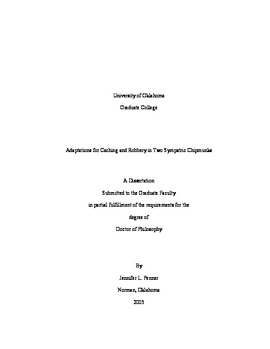| dc.contributor.advisor | Devenport, Lynn D., | en_US |
| dc.contributor.author | Penner, Jennifer L. | en_US |
| dc.date.accessioned | 2013-08-16T12:19:52Z | |
| dc.date.available | 2013-08-16T12:19:52Z | |
| dc.date.issued | 2005 | en_US |
| dc.identifier.uri | https://hdl.handle.net/11244/894 | |
| dc.description.abstract | We captured least chipmunks (Tamias minimus) and eastern chipmunks (T. striatus) from co-existing populations and assessed their comparative success at heterospecific robbery in a naturalistic laboratory setting. The smaller species (T. minimus) found their competitors' caches quickly and with little effort. The value of pilfered caches for least chipmunks was magnified by their lower energetic demands and the bigger cache size of their larger competitor. We traced the comparative success of least chipmunks to searching tactics that targeted the vulnerabilities of eastern chipmunk caches, and a cache placement counter-strategy that protected their own food stores. We suggest that heterospecific robbery may be especially beneficial for T. minimus and other small mammals by allowing them to narrow the competitive gap they experience with larger competitors. | en_US |
| dc.format.extent | v, 79 leaves : | en_US |
| dc.subject | Chipmunks. | en_US |
| dc.subject | Animals Food. | en_US |
| dc.subject | Animal behavior. | en_US |
| dc.subject | Biology, Zoology. | en_US |
| dc.title | Adaptations for caching and robbery in two sympatric chipmunks. | en_US |
| dc.type | Thesis | en_US |
| dc.thesis.degree | Ph.D. | en_US |
| dc.thesis.degreeDiscipline | Department of Psychology | en_US |
| dc.note | Source: Dissertation Abstracts International, Volume: 66-05, Section: B, page: 2459. | en_US |
| dc.note | Adviser: Lynn D. Devenport. | en_US |
| ou.identifier | (UMI)AAI3174405 | en_US |
| ou.group | College of Arts and Sciences::Department of Psychology | |
